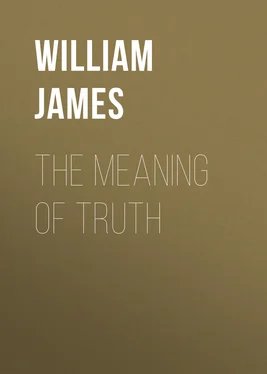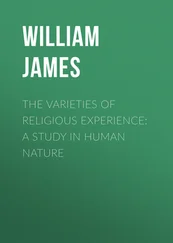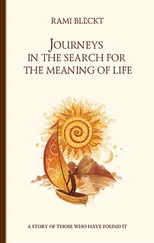William James - The Meaning of Truth
Здесь есть возможность читать онлайн «William James - The Meaning of Truth» — ознакомительный отрывок электронной книги совершенно бесплатно, а после прочтения отрывка купить полную версию. В некоторых случаях можно слушать аудио, скачать через торрент в формате fb2 и присутствует краткое содержание. Жанр: foreign_antique, Философия, foreign_edu, на английском языке. Описание произведения, (предисловие) а так же отзывы посетителей доступны на портале библиотеки ЛибКат.
- Название:The Meaning of Truth
- Автор:
- Жанр:
- Год:неизвестен
- ISBN:нет данных
- Рейтинг книги:3 / 5. Голосов: 1
-
Избранное:Добавить в избранное
- Отзывы:
-
Ваша оценка:
- 60
- 1
- 2
- 3
- 4
- 5
The Meaning of Truth: краткое содержание, описание и аннотация
Предлагаем к чтению аннотацию, описание, краткое содержание или предисловие (зависит от того, что написал сам автор книги «The Meaning of Truth»). Если вы не нашли необходимую информацию о книге — напишите в комментариях, мы постараемся отыскать её.
The Meaning of Truth — читать онлайн ознакомительный отрывок
Ниже представлен текст книги, разбитый по страницам. Система сохранения места последней прочитанной страницы, позволяет с удобством читать онлайн бесплатно книгу «The Meaning of Truth», без необходимости каждый раз заново искать на чём Вы остановились. Поставьте закладку, и сможете в любой момент перейти на страницу, на которой закончили чтение.
Интервал:
Закладка:
If this be so of percepts, how much more so of higher modes of thought! Even in the sphere of sensation individuals are probably different enough. Comparative study of the simplest conceptual elements seems to show a wider divergence still. And when it comes to general theories and emotional attitudes towards life, it is indeed time to say with Thackeray, 'My friend, two different universes walk about under your hat and under mine.'
What can save us at all and prevent us from flying asunder into a chaos of mutually repellent solipsisms? Through what can our several minds commune? Through nothing but the mutual resemblance of those of our perceptual feelings which have this power of modifying one another, WHICH ARE MERE DUMB KNOWLEDGES-OF-ACQUAINTANCE, and which must also resemble their realities or not know them aright at all. In such pieces of knowledge-of-acquaintance all our knowledge-about must end, and carry a sense of this possible termination as part of its content. These percepts, these termini, these sensible things, these mere matters-of-acquaintance, are the only realities we ever directly know, and the whole history of our thought is the history of our substitution of one of them for another, and the reduction of the substitute to the status of a conceptual sign. Contemned though they be by some thinkers, these sensations are the mother-earth, the anchorage, the stable rock, the first and last limits, the terminus a quo and the terminus ad quem of the mind. To find such sensational termini should be our aim with all our higher thought. They end discussion; they destroy the false conceit of knowledge; and without them we are all at sea with each other's meaning. If two men act alike on a percept, they believe themselves to feel alike about it; if not, they may suspect they know it in differing ways. We can never be sure we understand each other till we are able to bring the matter to this test. [Footnote: 'There is no distinction of meaning so fine as to consist in anything but a possible difference of practice.... It appears, then, that the rule for attaining the [highest] grade of clearness of apprehension is as follows: Consider what effects, which might conceivably have practical bearings, we conceive the object of our conception to have. Then, our conception of these effects is the whole of our conception of the object.' Charles S. Peirce: 'How to make our Ideas clear,' in Popular Science Monthly, New York, January, 1878, p. 293.] This is why metaphysical discussions are so much like fighting with the air; they have no practical issue of a sensational kind. 'Scientific' theories, on the other hand, always terminate in definite percepts. You can deduce a possible sensation from your theory and, taking me into your laboratory, prove that your theory is true of my world by giving me the sensation then and there. Beautiful is the flight of conceptual reason through the upper air of truth. No wonder philosophers are dazzled by it still, and no wonder they look with some disdain at the low earth of feeling from which the goddess launched herself aloft. But woe to her if she return not home to its acquaintance; Nirgends haften dann die unsicheren Sohlen—every crazy wind will take her, and, like a fire-balloon at night, she will go out among the stars.
NOTE.—The reader will easily see how much of the account of the truth-function developed later in Pragmatism was already explicit in this earlier article, and how much came to be defined later. In this earlier article we find distinctly asserted:—
1. The reality, external to the true idea;
2. The critic, reader, or epistemologist, with his own belief, as warrant for this reality's existence;
3. The experienceable environment, as the vehicle or medium connecting knower with known, and yielding the cognitive RELATION;
4. The notion of POINTING, through this medium, to the reality, as one condition of our being said to know it;
5. That of RESEMBLING it, and eventually AFFECTING it, as determining the pointing to IT and not to something else.
6. The elimination of the 'epistemological gulf,' so that the whole truth-relation falls inside of the continuities of concrete experience, and is constituted of particular processes, varying with every object and subject, and susceptible of being described in detail.
The defects in this earlier account are:—
1. The possibly undue prominence given to resembling, which altho a fundamental function in knowing truly, is so often dispensed with;
2. The undue emphasis laid upon operating on the object itself, which in many cases is indeed decisive of that being what we refer to, but which is often lacking, or replaced by operations on other things related to the object.
3. The imperfect development of the generalized notion of the WORKABILITY of the feeling or idea as equivalent to that SATISFACTORY ADAPTATION to the particular reality, which constitutes the truth of the idea. It is this more generalized notion, as covering all such specifications as pointing, fitting, operating or resembling, that distinguishes the developed view of Dewey, Schiller, and myself.
4. The treatment, [earlier], of percepts as the only realm of reality. I now treat concepts as a co-ordinate realm.
The next paper represents a somewhat broader grasp of the topic on the writer's part.
II
THE TIGERS IN INDIA [Footnote: Extracts from a presidential address before the American Psychological Association, published in the Psychological Review, vol. ii, p. 105 (1895).]
THERE are two ways of knowing things, knowing them immediately or intuitively, and knowing them conceptually or representatively. Altho such things as the white paper before our eyes can be known intuitively, most of the things we know, the tigers now in India, for example, or the scholastic system of philosophy, are known only representatively or symbolically.
Suppose, to fix our ideas, that we take first a case of conceptual knowledge; and let it be our knowledge of the tigers in India, as we sit here. Exactly what do we MEAN by saying that we here know the tigers? What is the precise fact that the cognition so confidently claimed is KNOWN-AS, to use Shadworth Hodgson's inelegant but valuable form of words?
Most men would answer that what we mean by knowing the tigers is having them, however absent in body, become in some way present to our thought; or that our knowledge of them is known as presence of our thought to them. A great mystery is usually made of this peculiar presence in absence; and the scholastic philosophy, which is only common sense grown pedantic, would explain it as a peculiar kind of existence, called INTENTIONAL EXISTENCE of the tigers in our mind. At the very least, people would say that what we mean by knowing the tigers is mentally POINTING towards them as we sit here.
But now what do we mean by POINTING, in such a case as this? What is the pointing known-as, here?
To this question I shall have to give a very prosaic answer—one that traverses the pre-possessions not only of common sense and scholasticism, but also those of nearly all the epistemological writers whom I have ever read. The answer, made brief, is this: The pointing of our thought to the tigers is known simply and solely as a procession of mental associates and motor consequences that follow on the thought, and that would lead harmoniously, if followed out, into some ideal or real context, or even into the immediate presence, of the tigers. It is known as our rejection of a jaguar, if that beast were shown us as a tiger; as our assent to a genuine tiger if so shown. It is known as our ability to utter all sorts of propositions which don't contradict other propositions that are true of the real tigers. It is even known, if we take the tigers very seriously, as actions of ours which may terminate in directly intuited tigers, as they would if we took a voyage to India for the purpose of tiger-hunting and brought back a lot of skins of the striped rascals which we had laid low. In all this there is no self-transcendency in our mental images TAKEN BY THEMSELVES. They are one phenomenal fact; the tigers are another; and their pointing to the tigers is a perfectly commonplace intra-experiential relation, IF YOU ONCE GRANT A CONNECTING WORLD TO BE THERE. In short, the ideas and the tigers are in themselves as loose and separate, to use Hume's language, as any two things can be; and pointing means here an operation as external and adventitious as any that nature yields.[Footnote: A stone in one field may 'fit,' we say, a hole in another field. But the relation of 'fitting,' so long as no one carries the stone to the hole and drops it in, is only one name for the fact that such an act MAY happen. Similarly with the knowing of the tigers here and now. It is only an anticipatory name for a further associative and terminative process that MAY occur.]
Читать дальшеИнтервал:
Закладка:
Похожие книги на «The Meaning of Truth»
Представляем Вашему вниманию похожие книги на «The Meaning of Truth» списком для выбора. Мы отобрали схожую по названию и смыслу литературу в надежде предоставить читателям больше вариантов отыскать новые, интересные, ещё непрочитанные произведения.
Обсуждение, отзывы о книге «The Meaning of Truth» и просто собственные мнения читателей. Оставьте ваши комментарии, напишите, что Вы думаете о произведении, его смысле или главных героях. Укажите что конкретно понравилось, а что нет, и почему Вы так считаете.












